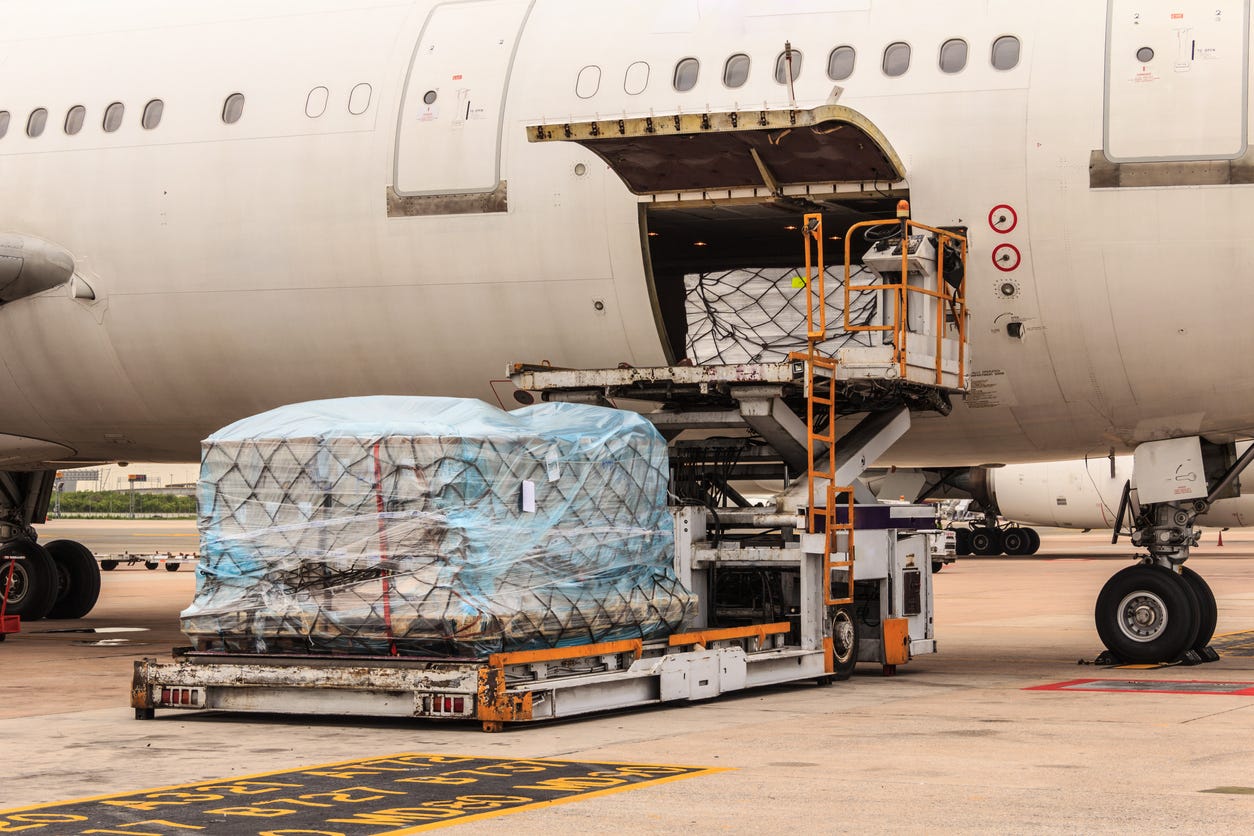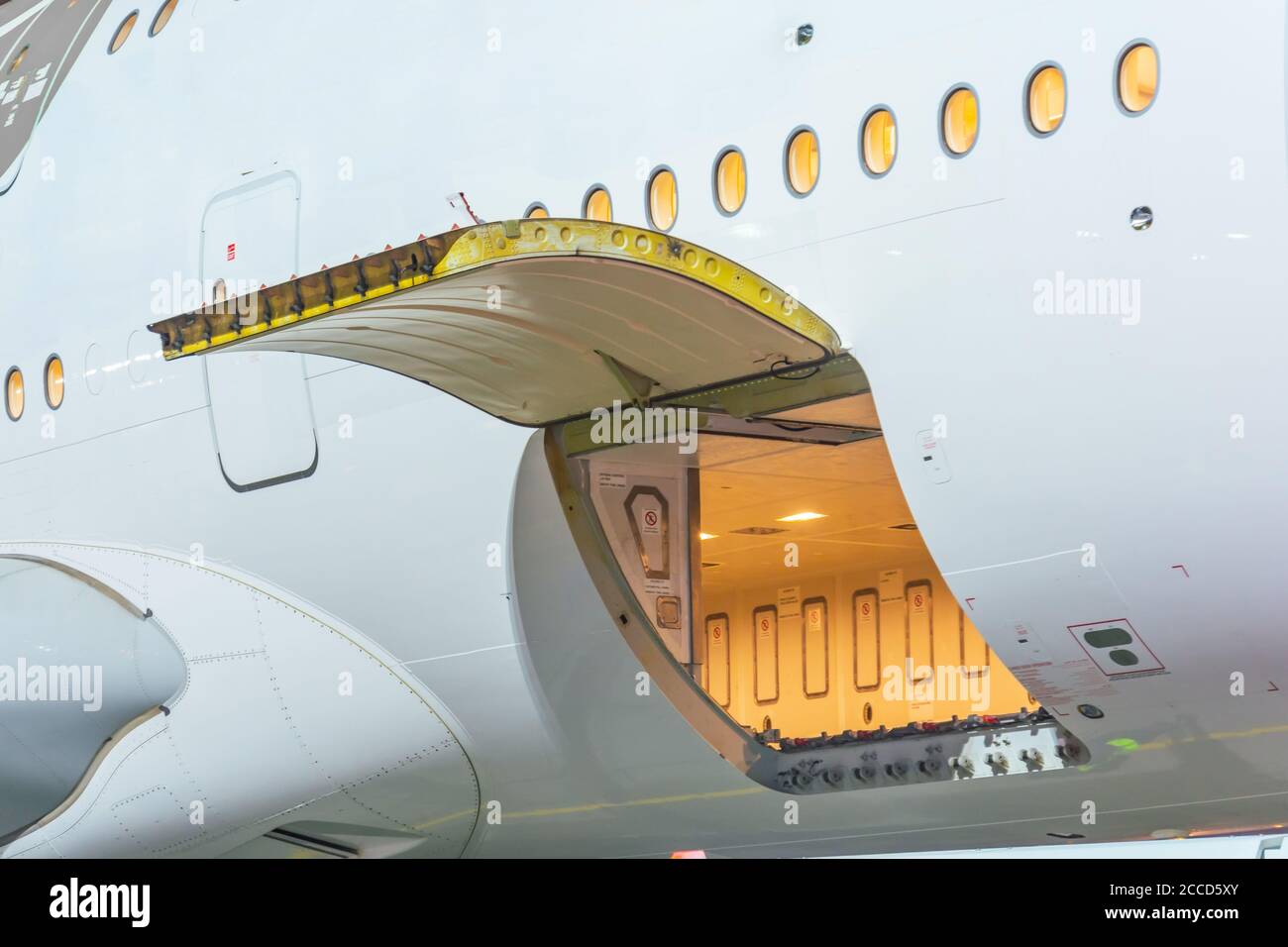Aircraft Uld - A unit load device (ULD) is a container used to load baggage, cargo, and mail onto wide-body aircraft and some narrow-body aircraft. It enables cargo pre-loading, container load compatibility to the aircraft, effective planning of aircraft weight and balance, and reduces the workload and time for loading the aircraft body compared to manual "bulk loading" of individual cargo or luggage. Each ULD has its own packing list or catalog to track its continuity. An aircraft cargo bed secured with a cargo net is also a ULD, but the size of its load must be weighed to ensure aircraft door and attachment clearances.
IATA publishes ULD regulations and notes that there are 900,000 services in use with a value of over $1 billion at an average cost of $1,100 each.
Aircraft Uld

ULDs come in two forms: pallets and containers. ULD pallets are strong aluminum plates, the rims of which are designed to lock into the lugs of the cargo net. ULD containers, also known as cans and pods, are closed containers made of aluminum or a combination of aluminum (frame) and Lexan (walls) and, depending on the nature of the cargo being transported, may have a built-in refrigeration unit. . . Below are examples of common ULDs and their special features.
Air Cargo Unit Load Device Market Size To Reach $427.5 Million In 2024
LD3s, LD6s and LD11s are suitable for 787s, 777s, 747s, MD-11s, Il-86s, Il-96s, L-1011s and all Airbus widebodies. Due to its narrow fuselage the 767 uses the smaller LD2 and LD8. The rare LD1 was designed specifically for the 747, but in general LD3s are commonly used (they have the same floor dimensions, so an LD3 replaces an LD1). The Airbus A320 family can carry reduced LD3s (1.14 m (45 in) instead of 1.63 m (64 in). LD7 pallets fit Airbus widebodies on the 787, 777, 747 and late model 767 models (with large doors).
It is possible to interchange some ULDs between LD3/6/11 machines and LD2/8 machines when cargo needs to be quickly transferred to a connecting flight. Both LD2 and LD8 can be loaded on LD3/6/11 aircraft, but with inefficient use of internal volume (33 feet).
Per wasted LD2). Only LD3 of the LD3/6/11 ULD family can be loaded into the 767; It takes a row of tires that fit two LD2s or one LD8 (90 ft).
The 787, which was intended to replace the 767, was designed to use the LD3/6/11 family of ULDs to solve the problem of wasted degraded volume.
Jettainer To Provide Uld Management Services For T'way Air
A Qatar Airways Airbus A380 at Heathrow Terminal 4 with various ground handling equipment including containers, pallet loader, ULD, jet launcher, belt loader, pushback tug, catering vehicles and dollies.
Aircraft loads may consist of containers, pallets or a combination of ULD types depending on requirements. In some aircraft some departments take only some ULDs so both types should be mixed.
An aircraft's container capacity is measured by seats. Each half-width container (LD1/LD2/LD3) on the aircraft designed for it has one seat. Generally, each line in the trunk contains two spaces. Therefore, the full-width container (LD6/LD8/LD11) takes up two positions. LD6 or LD11 can fill the space of two LD3. LD8 occupies the space of two LD2.

An aircraft's pallet capacity is measured by how many 96 x 125 inch (240 x 320 cm) PMC type LD7s can be stored. These boards have approximately three LD3 positions (two positions in one row and half of the two positions in the next row) or four LD2 positions. PMCs can only be loaded into cargo compartments with large doors designed to receive them (small door compartments are just containers).
Unit Load Device Uld Air Container Specifications
A 4- or 5-digit serial number (4 if before October 1, 1993; either 4 or 5 if after October 1, 1993) and two character (alphanumeric) identifying the owner of the ULD to distinguish it from other entries of the same type (if it is an airline, often similar to IATA identifier codes). For example, AKN 12345 DL means that the ULD is a forklift LD3 with the unique number 12345 and is owned by Delta Air Lines.
Cargo aircraft have ULDs 79 to 96 inches (2,007 to 2,438 mm) high on the main deck, with footprints similar to 88-inch (2,235 mm) or 96-inch (2,438 mm) wide planks. 62 inches (1575 mm) or 125 inches (3175 mm) long. The 62 in. (1,575 mm) wide × 88 in. (2,235 mm) tall ULD is half the volume of the 125 in. (3,175 mm) × 88 in. stage. The 20-foot platform is 238 inches (6,045 mm) long and 96 inches (2,438 mm) wide. Since most manufacturers only provide profile width, length, and height information, it is very difficult to know the actual dimensions of molded top layer ULDs.
There are several common types of contoured main deck ULDs that are contoured (curved to fit the fuselage) to provide maximum cargo capacity. Initially, the ULD design was a triangle with one or both corners removed from the ULD's profile, like the standard LD3 and LD6. The main deck ULDs use a curved outline to maximize cargo volume. Upper layer ULDs are similar to lower layer ULDs except that they span the full width of the layer without two corners of the profile (lower deck LD6 lower) or are cut in half from the centerline of the container layer (below ). cover LD3 and top layer AAX).
Main deck ULDs and pallets are not only taller than lower deck ULDs, but often two to four times longer. They are usually configured like one LD6 with plain width and two profile corners, or two LD3s stored side by side that are too long to use plain width and missing a profile corner each, but often two or four times as long. From the nose to the tail of the aircraft.
Unilode Expands Its Global Uld Repair Network
Many air cargo companies use main deck ULDs, which are called double profiles, so on smaller aircraft like the Boeing 727 they are kept wide and shaped like two cones, and on the larger Boeing 767 they can be turned 90 degrees to the side. On the same side as LD3, so only a cone shape when used as LD3. This greatly simplifies the transportation of cargo containers at a lower cost of cargo volume. Much of the international negotiation between sea freight and air freight is based on three key factors – cost, risk and speed. When it comes to the latter two, air cargo always wins. Of course, it comes at a price, but air freight is the right answer for companies that send small packages or LCLs frequently and need international freight to move quickly and safely.
While most shippers understand international ocean shipping container shipping, few fully understand how to load cargo on an airplane. Aviation seems to be almost a "dark art" that few truly understand. As a forwarder who constantly transports air cargo around the world, we would like to tell you about a few shipping methods - primarily by providing information on two air cargo loading devices!
If you haven't read our previous post on ULD, that's a good place to start, but we'll cover it here. ULD is short for unit load device, which is the cargo "device" that is placed/into the aircraft before it is placed on the aircraft for transport. We use the term "equipment" rather than "container" because, unlike ocean transportation, not all cargo is transported in containers in air transportation.

ULD containers, simply put, are a container-shaped means of transporting air cargo. Unlike standard international ocean freight containers, ULD containers have specific (and slightly odd) dimensions designed to fit a standard aircraft.
Jettainer: Growing In Asia. 2022 And Beyond
If you look for pictures of ULD tanks, you'll immediately notice the oddly angled sides. The shapes of these containers are intended to maximize the space available under the plane - especially for passenger flights (which can be used by shippers known to the TSA). Obviously, this means that certain restrictions apply to cargo dimensions.
In general, air freight works better for smaller shipments than ocean freight, but if you ship frequently using LCL methods, you may be surprised at how much you can fit into a ULD container.
ULD containers are almost always owned and controlled by air carriers. In other words, you will never order or rent a ULD container to ship to your warehouse. Send your cargo to the airline and they will combine it with the appropriate ULD on site at the port.
ULD pallets are another form of unit load equipment used in air cargo. However, ULD pallets are different from standard wood warehouse transport pallets. Airplanes have special requirements for loading and unloading cargo - it's not as simple as picking up an old wooden pallet with a forklift and rolling it onto an ocean liner.
Uld Air Freight Cargo Handling
ULD planks are particularly durable and are often manufactured
Uld bp 300, uld manufacturers, uld vest, amprobe uld 300, uld container, pmc uld, joha uld, leprecon uld 360, aircraft uld types, uld, uld 300, uld aircraft
0 Comments